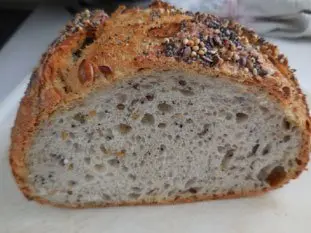Seeded loaf
A recipe from cooking-ez.com October 24th 2017174 K3.9
For 2 loaves, you will need:
- 1 50 g sesame seeds
- 2 50 g linseed
- 3 50 g poppy seeds
- 4 50 g millet
- 5 200 ml water
- 6 1 kg plain white flour (French Type 65)
- 7 18 g salt
- 8 250 g leaven
- 9 7 g yeast
- 10 600 g water
- Total weight: 2,275 grams
Times:
| Preparation | Resting | Cooking | Start to finish |
|---|---|---|---|
| 50 min. | 2 hours 50 min. | 50 min. | 4 hours 30 min. |
Step by step recipe
- 1: Preheat the oven to 360°F (180°C).
Mix 50 g sesame seeds, 50 g linseed, 50 g poppy seeds and 50 g millet (see below for more about seeds). - 2: Set aside 2 tablespoonsful of seeds to go on top of the loaves.
- 3: Lay a sheet of cooking parchment on a baking sheet and spread out the seeds evenly on this.
Put in the oven for 20 minutes to dry roast. - 4: Pour 200 ml water into a bowl.
- 5: As soon as you take the seeds out of the oven, tip them into the water. The paper is useful for this.
- 6: Leave the seeds to absorb the water while you make the bread dough.
You will see that the weight of water is the same as the weight of seeds. - 7: In bread-making, the water temperature is always important. It's not a fixed value, but related to 3 other temperatures: 1) the temperature of your flour, 2) the room temperature in your kitchen, and 3) the basic temperature of this recipe, which is 56-60°C.
You can calculate the temperature of the water for this recipe in one click, using this small calculator. - 8: Put into a food-processor bowl: 1 kg plain white flour (French Type 65), 18 g salt, 250 g leaven, 7 g yeast and 600 g water.
Knead on slow speed for 18 minutes or, to be more precise, check for the gluten membrane using the window-pane test (see how in this video). - 9: Then add the seeds (which should have absorbed all the water) to the dough.
- 10: Knead for a few more minutes, just to mix the seeds in.
Note: For the best way to knead, see: A few tips for effective kneading at home. - 11: Gather the dough into a ball and transfer to a clean bowl, cover with a plastic sheet and leave to rest for 1 hour 30 minutes.
- 12: After resting, cut the dough into 1 kg (2 lb) lumps.
- 13: Shape these lumps of dough into nice round balls (see how to do it in this video)...
- 14: ...and cover with a plastic sheet.
Leave to rest for 20 minutes. - 15: Prepare your proving baskets (bannetons), if you have them, by scattering a tablespoonful of seeds in the bottom.
- 16: Shape your loaves (see how to do it in this video), and place in the baskets with the "seam" on top (they will be turned the other way up to cook).
- 17: Cover with the plastic sheet once more and leave to rise for 1 hour.
- 18: Preheat the oven to 460°F (240°C) then bake the loaves for about 30-40 minutes, after slashing the tops.
Note: As when baking any bread, you should ensure that the oven is filled with steam for the first 15 minutes of baking. This page shows you how; it really is the secret of golden-brown, crusty loaves.. - 19: Leave to cool on a wire rack.
Remarks
Feel free to use different seeds in the mixture, either as replacements or in addition: pumpkin seeds, dark or light linseeds, oats, etc., but do try to keep to the proportion of 200g of seeds per kilogram (approx. 2 lb) of flour.View this recipe : https://cooking-ez.com/four/recipe-seeded-loaf.php
December 22th 2025.

